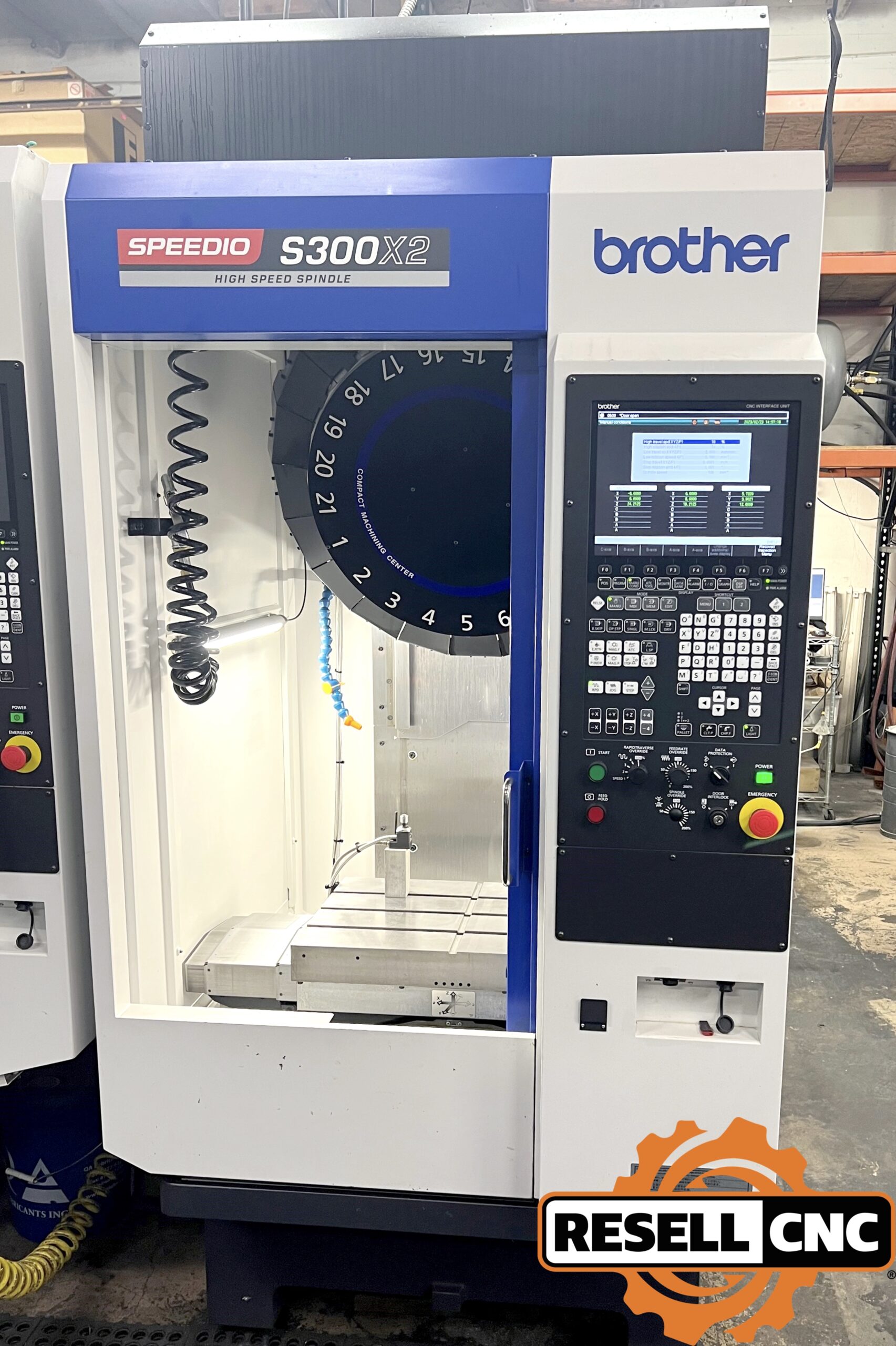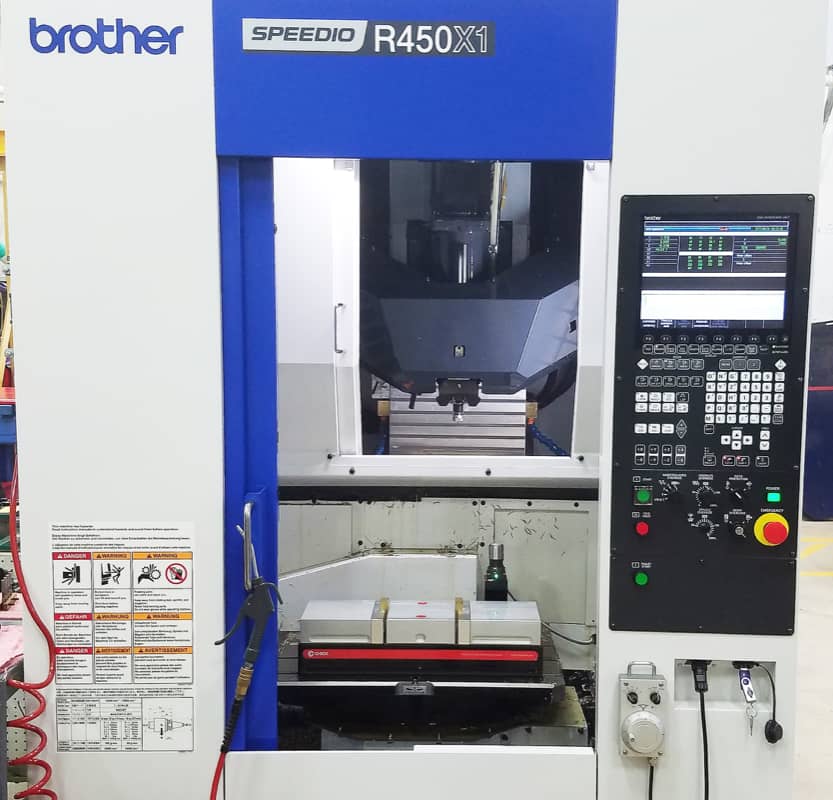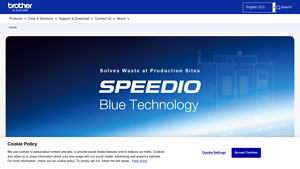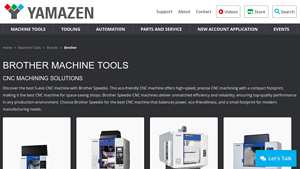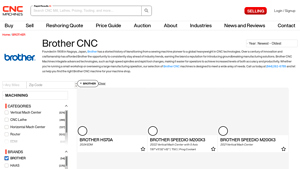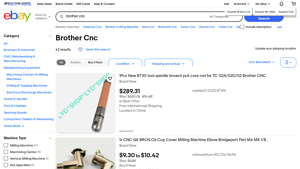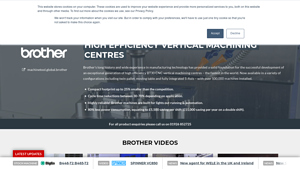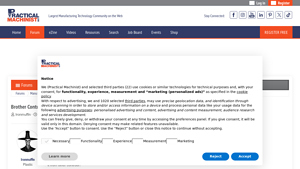Brother Cnc Machine Guide: Type, Cost, Top List…
Introduction: Navigating the Global Market for brother cnc machine
In today’s fast-paced manufacturing landscape, sourcing the right Brother CNC machine can present significant challenges for international B2B buyers. As industries across Africa, South America, the Middle East, and Europe strive for efficiency and precision, the need for compact, high-speed machining solutions has never been greater. This guide aims to illuminate the complex global market for Brother CNC machines, providing insights into various types, including vertical and horizontal machining centers, multi-tasking machines, and 5-axis systems.
Throughout this comprehensive resource, we will explore critical applications across diverse sectors, from automotive to aerospace, and the essential criteria for vetting suppliers effectively. Additionally, we’ll delve into cost considerations, helping buyers understand the total cost of ownership and potential ROI. By equipping B2B buyers with the knowledge to make informed purchasing decisions, this guide not only simplifies the sourcing process but also empowers businesses to enhance their operational efficiency and competitiveness in a global market. Whether you are in Vietnam, Saudi Arabia, or anywhere in between, understanding the nuances of Brother CNC machines will enable you to select the best solutions tailored to your specific manufacturing needs.
Understanding brother cnc machine Types and Variations
| Type Name | Key Distinguishing Features | Primary B2B Applications | Brief Pros & Cons for Buyers |
|---|---|---|---|
| SPEEDIO Vertical Machining Center | High-speed spindle, compact design, rapid tool change | Aerospace, automotive, electronics | Pros: High productivity, space-saving; Cons: Initial investment can be high. |
| SPEEDIO Horizontal Machining Center | BT30 spindle, wide jig area, optimized for large workpieces | Industrial components, valve parts | Pros: Enhanced precision, versatile; Cons: Limited to horizontal operations. |
| SPEEDIO 5-Axis Machining Center | Simultaneous 5-axis control, advanced tool management | Complex part manufacturing, mold making | Pros: Capable of intricate designs; Cons: Requires skilled operators. |
| Multi-Tasking Machine | Combines turning and milling processes in one unit | Prototyping, small batch production | Pros: Reduces setup time, increases efficiency; Cons: Complexity in operation. |
| Deburring Center | Specializes in deburring processes with quick operation | Finishing processes in metalworking | Pros: Streamlines finishing; Cons: Limited to deburring tasks. |
What Are the Key Characteristics of the SPEEDIO Vertical Machining Center?
The SPEEDIO Vertical Machining Center is designed for high-speed operations, featuring advanced spindle technology and a compact footprint. This model is particularly well-suited for industries like aerospace and automotive, where precision and speed are crucial. When considering this machine, buyers should evaluate their production volume and space constraints, as this model excels in environments where quick turnaround times and efficient use of space are priorities.
How Does the SPEEDIO Horizontal Machining Center Stand Out?
The SPEEDIO Horizontal Machining Center is notable for its BT30 spindle and expansive jig area, making it ideal for machining larger workpieces. It is commonly used in the production of industrial components and valve parts. Buyers should consider the types of materials they will be working with and the complexity of their parts, as this machine offers enhanced precision but is limited to horizontal operations.
Why Choose the SPEEDIO 5-Axis Machining Center?
The SPEEDIO 5-Axis Machining Center features simultaneous 5-axis control, allowing for the machining of complex geometries with high accuracy. This machine is particularly effective for industries involved in complex part manufacturing and mold making. Prospective buyers should assess their need for intricate designs and the availability of skilled operators, as this machine requires a higher level of expertise to operate effectively.
What Are the Benefits of a Multi-Tasking Machine?
Multi-Tasking Machines integrate turning and milling functions, which significantly reduces setup time and increases overall efficiency. These machines are especially beneficial for prototyping and small batch production. Buyers should consider the complexity of their projects and whether they require the versatility offered by this type of machine, as it can streamline workflows but may also introduce operational complexity.
When Should You Consider a Deburring Center?
Deburring Centers are specialized machines designed to efficiently remove burrs from machined parts, enhancing the finishing process in metalworking applications. These machines are crucial for companies looking to improve the quality of their finished products. Buyers should evaluate their finishing needs and whether their production volume justifies investing in a dedicated deburring machine, as it provides significant time savings in post-processing but is limited to deburring tasks.
Key Industrial Applications of brother cnc machine
| Industry/Sector | Specific Application of brother cnc machine | Value/Benefit for the Business | Key Sourcing Considerations for this Application |
|---|---|---|---|
| Aerospace | Precision component manufacturing | High accuracy and reduced waste in part production | Certifications for aerospace standards; availability of spare parts and service support. |
| Automotive | Engine and transmission part machining | Increased productivity with rapid tool change capability | Compliance with automotive quality standards; local support for maintenance and training. |
| Electronics | Production of semiconductor and PCB parts | Enhanced precision and efficiency in high-volume runs | Compatibility with specific materials; supply chain reliability for components. |
| Medical Devices | Manufacturing surgical instruments | Consistent quality and precision for safety-critical items | Regulatory compliance (FDA, CE); support for prototyping and small batch runs. |
| Energy Sector | Machining of valve and turbine components | Improved operational efficiency and reduced downtime | Access to skilled technicians; adaptability to various materials and sizes. |
How Are Brother CNC Machines Used in the Aerospace Industry?
In the aerospace sector, Brother CNC machines are utilized for precision component manufacturing, including engine parts and structural elements. The machines’ high-speed capabilities and accuracy minimize material waste, ensuring cost-effective production. Buyers in this industry must consider certifications that adhere to stringent aerospace standards, as well as the availability of spare parts and robust service support to ensure operational continuity.
What Role Do Brother CNC Machines Play in Automotive Manufacturing?
In automotive manufacturing, Brother CNC machines excel in machining engine and transmission components. Their rapid tool change capabilities significantly enhance productivity, allowing manufacturers to meet high demand efficiently. B2B buyers should focus on sourcing machines that comply with automotive quality standards and ensure local support for maintenance and training, which is critical for keeping production lines running smoothly.
How Are Brother CNC Machines Transforming Electronics Production?
Brother CNC machines are integral in the production of semiconductor and PCB parts, where precision and efficiency are paramount. Their ability to handle high-volume runs without sacrificing quality makes them ideal for the electronics industry. Buyers should prioritize compatibility with specific materials and ensure a reliable supply chain for components to maintain uninterrupted production.
Why Are Brother CNC Machines Essential for Medical Device Manufacturing?
In the medical device sector, Brother CNC machines are used to manufacture surgical instruments that require consistent quality and precision. The reliability of these machines is crucial for safety-critical applications. Buyers need to ensure compliance with regulatory standards, such as FDA and CE certifications, and seek support for prototyping and small batch runs to adapt to changing market needs.
How Do Brother CNC Machines Benefit the Energy Sector?
Brother CNC machines are employed in the energy sector for machining valve and turbine components, where improved operational efficiency is essential. Their capability to adapt to various materials and sizes can significantly reduce downtime and enhance performance. Buyers should consider access to skilled technicians and the machine’s adaptability to ensure they meet the specific demands of energy production.
3 Common User Pain Points for ‘brother cnc machine’ & Their Solutions
Scenario 1: High Setup and Changeover Times Affecting Production Efficiency
The Problem:
B2B buyers often grapple with the challenge of long setup and changeover times when using Brother CNC machines. In a competitive manufacturing environment, every minute counts, and delays in transitioning from one job to another can lead to significant downtime. This is especially critical for manufacturers dealing with small batch production, where the ability to quickly switch between different parts is essential. High changeover times not only affect productivity but also increase labor costs and can result in missed deadlines, ultimately impacting customer satisfaction.
The Solution:
To mitigate this issue, buyers should focus on optimizing their setup procedures by utilizing the automatic tool change (ATC) features inherent in Brother CNC machines. For example, the SPEEDIO series is equipped with high-speed ATC systems that can change tools in as little as 1.1 seconds. B2B buyers can maximize this advantage by standardizing tool setups and maintaining a well-organized tool inventory. Implementing a well-documented setup protocol can streamline the process. Additionally, investing in training for operators to utilize these features effectively can significantly reduce changeover times, leading to enhanced productivity and improved operational efficiency.
Scenario 2: Difficulty in Achieving Precision and Quality in Complex Machining
The Problem:
Another common pain point for buyers is the struggle to achieve consistent precision and quality in complex machining tasks, especially when dealing with intricate designs or high-tolerance specifications. This is particularly true in industries such as aerospace, automotive, and medical device manufacturing, where precision is non-negotiable. Inconsistent quality can lead to increased scrap rates, costly rework, and ultimately, a tarnished reputation in the market.
The Solution:
To address these quality challenges, buyers should leverage the advanced features of Brother CNC machines that promote high accuracy. The SPEEDIO series, for instance, incorporates sophisticated CNC control systems, like the CNC-D00, that optimize machining processes by reducing operational waste and improving control over machining parameters. B2B buyers are advised to invest in thorough calibration and maintenance schedules to ensure machines are always operating at their best. Furthermore, utilizing simulation software can allow for virtual testing of machining processes, enabling operators to identify potential issues before physical production begins. This proactive approach not only enhances precision but also minimizes material waste and enhances overall product quality.
Scenario 3: Challenges in Integrating Automation with Existing Systems
The Problem:
As manufacturers aim to modernize their operations, many B2B buyers face integration challenges when incorporating automation technologies with existing Brother CNC machines. There is often a lack of clarity on how to effectively integrate these systems without disrupting current workflows or requiring extensive retraining of staff. These challenges can lead to hesitance in adopting automation, which is critical for staying competitive in the global market.
The Solution:
To overcome integration hurdles, buyers should begin by conducting a comprehensive assessment of their current systems and processes. Identifying specific areas where automation can add value will allow for targeted investments. Brother CNC machines come with various compatibility options for automation solutions, such as robotic arms for material handling and loading. Buyers should consider consulting with Brother’s technical support or authorized distributors to understand the best practices for integration. Additionally, phased implementation can help in minimizing disruptions; starting with one machine or process can provide valuable insights into the integration process before a full-scale rollout. Emphasizing training and support for operators during this transition will ensure a smoother integration and enhance overall operational efficiency.
Strategic Material Selection Guide for brother cnc machine
What Materials Are Commonly Used with Brother CNC Machines?
When selecting materials for machining with Brother CNC machines, it is essential to consider the properties, advantages, and limitations of each material. This guide analyzes four common materials: aluminum, stainless steel, plastics, and titanium. Each material has unique characteristics that influence its suitability for various applications.
How Does Aluminum Perform in CNC Machining?
Aluminum is a widely used material in CNC machining due to its excellent machinability and lightweight properties. It has a low density, making it ideal for applications where weight reduction is crucial, such as in the aerospace and automotive industries. Key properties include good corrosion resistance and thermal conductivity, allowing for efficient heat dissipation during machining.
Pros: Aluminum is relatively inexpensive, easy to machine, and can be anodized for enhanced surface protection. Its lightweight nature also contributes to lower shipping costs.
Cons: While aluminum is durable, it may not withstand high-temperature applications as effectively as some metals. Additionally, it can be prone to scratching and denting.
Impact on Application: Aluminum is compatible with various media, including air and water, making it suitable for components in automotive and aerospace applications.
International Considerations: Buyers should ensure compliance with international standards such as ASTM B221 for aluminum extrusions. In regions like Africa and South America, sourcing local suppliers can minimize costs and lead times.
What Are the Benefits of Using Stainless Steel?
Stainless steel is another popular material choice for CNC machining, known for its strength, durability, and resistance to corrosion. With a higher temperature rating than aluminum, it is suitable for applications requiring high strength and toughness, such as in medical devices and industrial equipment.
Pros: Stainless steel is highly durable and can withstand harsh environments. Its corrosion resistance makes it ideal for applications exposed to moisture and chemicals.
Cons: The machining process for stainless steel is more complex and can lead to higher tooling costs. Additionally, its higher density increases shipping costs.
Impact on Application: Stainless steel is compatible with a wide range of media, including corrosive substances, making it suitable for food processing and pharmaceutical applications.
International Considerations: Compliance with standards like ASTM A240 is crucial for international buyers. In regions such as the Middle East, understanding local regulations regarding food safety can impact material selection.
How Do Plastics Compare in CNC Machining?
Plastics, such as polycarbonate and acrylic, are increasingly used in CNC machining due to their versatility and lightweight properties. They offer excellent machinability and can be produced in various colors and finishes.
Pros: Plastics are generally low-cost materials that provide good resistance to chemicals and moisture. They are also lightweight, reducing shipping costs.
Cons: Plastics may not be suitable for high-temperature applications, as they can deform under heat. They also tend to have lower mechanical strength compared to metals.
Impact on Application: Plastics are often used in consumer products, medical devices, and electronic housings, where weight and design flexibility are critical.
International Considerations: Buyers should consider compliance with standards like ISO 9001 for quality management. In Europe, regulations regarding plastic recycling and sustainability may influence material choices.
What Makes Titanium a Unique Choice for CNC Machining?
Titanium is renowned for its high strength-to-weight ratio and exceptional corrosion resistance, making it a preferred material for aerospace and medical applications. Its ability to withstand extreme temperatures enhances its appeal.
Pros: Titanium is incredibly strong and durable, making it suitable for demanding applications. It also offers excellent biocompatibility, which is crucial in medical devices.
Cons: The high cost of titanium and its challenging machinability can lead to increased production expenses. Specialized tooling may be required to achieve desired tolerances.
Impact on Application: Titanium is compatible with a variety of media, including corrosive environments, making it ideal for aerospace and medical applications.
International Considerations: Compliance with standards such as ASTM F136 for medical applications is vital. Buyers in regions like Europe should be aware of stringent regulations regarding aerospace materials.
Summary Table of Material Selection for Brother CNC Machines
| Material | Typical Use Case for brother cnc machine | Key Advantage | Key Disadvantage/Limitation | Relative Cost (Low/Med/High) |
|---|---|---|---|---|
| Aluminum | Aerospace components, automotive parts | Lightweight and easy to machine | Less effective at high temperatures | Low |
| Stainless Steel | Medical devices, industrial equipment | Highly durable and corrosion-resistant | More complex machining process | Med |
| Plastics | Consumer products, electronic housings | Low-cost and versatile | Lower mechanical strength | Low |
| Titanium | Aerospace components, medical implants | High strength-to-weight ratio | High cost and challenging to machine | High |
This guide provides B2B buyers with actionable insights into material selection for Brother CNC machines, ensuring informed decisions that align with their operational needs and regional compliance requirements.
In-depth Look: Manufacturing Processes and Quality Assurance for brother cnc machine
What Are the Key Stages in the Manufacturing Process of Brother CNC Machines?
The manufacturing process of Brother CNC machines is meticulously designed to ensure high precision and efficiency. This process can be broken down into four main stages: material preparation, forming, assembly, and finishing.
-
Material Preparation
The process begins with the selection of high-quality materials, typically aluminum and steel, which are chosen for their strength and machinability. The materials undergo rigorous inspections to ensure they meet the necessary specifications. They are then cut to size using advanced cutting tools, ensuring minimal waste and optimal use of resources. -
Forming
In this stage, the prepared materials are subjected to various machining processes. Brother CNC machines utilize state-of-the-art technologies such as high-speed spindles and rapid tool changes, enabling precise shaping and contouring of components. Techniques such as milling, turning, and drilling are employed, often in a simultaneous multi-axis configuration, to achieve complex geometries. -
Assembly
Following the forming stage, the individual components are assembled. This process often employs automated assembly systems to enhance speed and accuracy. Each component is fitted and secured according to strict engineering specifications. Quality checks are integrated into the assembly line to identify any discrepancies early in the process. -
Finishing
The final stage involves surface finishing and treatment, which may include anodizing, painting, or coating to enhance durability and aesthetic appeal. Finishing processes are critical as they directly impact the performance and longevity of the machine. Post-finishing inspections are conducted to ensure that all components meet the required quality standards.
How Does Quality Assurance Ensure the Reliability of Brother CNC Machines?
Quality assurance is paramount in the manufacturing of Brother CNC machines. Adhering to international standards, such as ISO 9001, and industry-specific certifications like CE and API, Brother implements a comprehensive quality management system throughout the manufacturing process.
-
What Are the Relevant International Standards for Brother CNC Machines?
ISO 9001 serves as a foundation for quality management, emphasizing a process approach and continuous improvement. Compliance with CE marking indicates that the machines meet European health, safety, and environmental protection standards. For industries like oil and gas, API certification ensures that the machinery adheres to industry-specific quality standards. -
What Quality Control Checkpoints Are Implemented?
Quality control checkpoints are established at various stages of the manufacturing process:
-
Incoming Quality Control (IQC): This initial checkpoint involves inspecting raw materials before they enter production. Materials are tested for compliance with specifications, preventing defects early in the process.
-
In-Process Quality Control (IPQC): Throughout the manufacturing process, IPQC ensures that operations adhere to quality standards. Techniques such as statistical process control (SPC) are used to monitor production parameters and detect variations.
-
Final Quality Control (FQC): After assembly and finishing, FQC involves thorough inspections and testing of the final product. This includes functional tests, dimensional checks, and performance evaluations to ensure the machine operates as intended.
- What Common Testing Methods Are Utilized?
Brother employs various testing methods to validate the performance and reliability of their CNC machines. These may include:
- Functional Testing: Assessing the machine’s operational capabilities under simulated conditions.
- Dimensional Inspection: Using precision measuring instruments to verify that components meet specified tolerances.
- Performance Testing: Evaluating machine speed, accuracy, and efficiency to ensure it meets production requirements.
How Can B2B Buyers Verify the Quality Control of Brother CNC Machines?
For international B2B buyers, particularly those from Africa, South America, the Middle East, and Europe, verifying the quality control processes of suppliers is critical. Here are several strategies to ensure due diligence:
-
Conducting Supplier Audits
Buyers should engage in regular audits of their suppliers’ manufacturing facilities. This allows for firsthand observation of production practices, quality control measures, and compliance with international standards. Audits can also reveal the supplier’s commitment to continuous improvement. -
Requesting Quality Assurance Documentation
B2B buyers can request detailed quality assurance documentation, including certificates of compliance, inspection reports, and quality control records. This documentation provides insights into the supplier’s adherence to quality standards and highlights any potential issues that have been addressed. -
Engaging Third-Party Inspection Services
Utilizing third-party inspection services can offer an unbiased assessment of the supplier’s quality control processes. These services can conduct independent evaluations and provide reports that help buyers make informed decisions.
What Are the Quality Control Nuances for International B2B Buyers?
When sourcing Brother CNC machines, international buyers must navigate various nuances in quality control that can vary by region:
-
Cultural Considerations
Different regions may have varying expectations regarding quality and compliance. Understanding local standards and practices can help buyers better communicate their requirements and ensure alignment with supplier capabilities. -
Regulatory Compliance
Compliance with local regulations, such as environmental laws or safety standards, is crucial. Buyers should ensure that their suppliers are not only compliant with international standards but also with local regulations in the markets they operate. -
Building Relationships with Suppliers
Establishing strong relationships with suppliers can facilitate better communication regarding quality expectations. Regular interaction can also help in resolving issues quickly and collaboratively, leading to improved product quality over time.
In conclusion, understanding the manufacturing processes and quality assurance systems of Brother CNC machines is essential for B2B buyers. By focusing on rigorous quality control measures and verifying supplier standards, buyers can ensure they are investing in reliable machinery that meets their production needs.
Practical Sourcing Guide: A Step-by-Step Checklist for ‘brother cnc machine’
Introduction
This practical sourcing guide is designed to assist B2B buyers in procuring Brother CNC machines effectively. With a focus on maximizing productivity and operational efficiency, this checklist outlines essential steps to ensure that you make informed purchasing decisions tailored to your specific manufacturing needs.
Step 1: Define Your Technical Specifications
Before initiating your search, clearly outline the technical specifications required for your operations. Consider the types of materials you’ll be machining, desired precision, and production volume. This step is crucial to ensure that the Brother CNC machine you select aligns perfectly with your manufacturing capabilities and goals.
- Material Compatibility: Identify if the machine can handle the materials you commonly work with, such as aluminum, steel, or composites.
- Precision and Speed Requirements: Determine the accuracy levels and speed of operation needed for your projects.
Step 2: Research Available Models
Explore the various models offered in the Brother CNC machine lineup, such as the SPEEDIO series. Each model has unique features that cater to different industrial applications, from compact machining centers to multi-tasking machines.
- Model Features: Look for specifications like spindle speed, tool change time, and 5-axis capabilities.
- Industry Applications: Ensure the model suits your industry, whether it’s automotive, aerospace, or electronics.
Step 3: Evaluate Potential Suppliers
Thoroughly vet potential suppliers to ensure reliability and quality. Request detailed company profiles, customer references, and case studies from buyers in similar industries or regions.
- Supplier Reputation: Check online reviews and testimonials to gauge the supplier’s standing in the market.
- After-Sales Support: Inquire about warranty, maintenance services, and parts availability.
Step 4: Request Quotes and Compare Pricing
Obtain detailed quotes from multiple suppliers. This step allows you to compare not only prices but also the terms of service, delivery timelines, and payment options.
- Cost Breakdown: Look for transparency in pricing, including machine costs, installation fees, and training expenses.
- Total Cost of Ownership: Consider long-term operational costs, such as energy consumption and maintenance.
Step 5: Verify Certifications and Compliance
Ensure that the machines meet international quality standards and certifications relevant to your region. Compliance with safety and environmental regulations is crucial for smooth operations.
- Quality Standards: Check for certifications like ISO 9001, which indicates adherence to quality management principles.
- Local Regulations: Understand any regional compliance requirements to avoid potential legal issues.
Step 6: Plan for Installation and Training
Discuss installation and operator training with your supplier. A well-executed installation and comprehensive training program will enhance your team’s proficiency and machine performance.
- Installation Support: Confirm that the supplier provides installation assistance and troubleshooting during the initial setup.
- Training Programs: Look for training options that cover machine operation, maintenance, and troubleshooting.
Step 7: Establish a Follow-Up Plan
After the purchase, set a schedule for regular follow-ups with the supplier. This ensures ongoing support and helps address any operational issues promptly.
- Feedback Mechanism: Create a channel for feedback to continuously improve your operational efficiency.
- Maintenance Schedule: Establish a maintenance routine based on supplier recommendations to prolong machine life and performance.
By following this checklist, you can navigate the complexities of sourcing Brother CNC machines with confidence, ensuring that your investment leads to enhanced productivity and efficiency in your operations.
Comprehensive Cost and Pricing Analysis for brother cnc machine Sourcing
What Are the Key Cost Components in Sourcing Brother CNC Machines?
When considering the procurement of Brother CNC machines, understanding the cost structure is crucial for optimizing your budget. The main cost components typically include materials, labor, manufacturing overhead, tooling, quality control (QC), logistics, and the supplier’s margin.
-
Materials: The quality of materials used significantly impacts the overall cost. Brother CNC machines utilize high-grade components to ensure durability and precision, which can elevate prices. Buyers should assess whether the materials align with their production needs.
-
Labor: Labor costs encompass both direct and indirect expenses related to the assembly and manufacturing of CNC machines. Skilled labor is essential for quality assurance and effective machine operation, which can contribute to higher costs.
-
Manufacturing Overhead: This includes utilities, rent, and administrative expenses associated with the production facilities. Understanding these costs can help buyers gauge the total cost of ownership.
-
Tooling: Specialized tooling can add to the initial investment. Buyers should consider whether the required tooling is included in the purchase or if additional investments are needed.
-
Quality Control: Rigorous QC processes ensure that machines meet Brother’s high standards, which can add to manufacturing costs but ultimately contributes to reliability and performance.
-
Logistics: Shipping and handling costs can vary significantly based on the destination and the chosen Incoterms. This is especially relevant for international buyers from regions like Africa, South America, and the Middle East.
-
Margin: Suppliers often include a margin in their pricing to cover business expenses and profit. Understanding this can assist in negotiation.
How Do Price Influencers Affect Brother CNC Machine Costs?
Several factors influence the pricing of Brother CNC machines, including volume or minimum order quantities (MOQ), specifications and customization options, and the quality certifications of the machines.
-
Volume/MOQ: Purchasing in larger quantities can lead to significant discounts. Buyers should evaluate their production requirements to leverage bulk purchasing.
-
Specifications/Customization: Custom features, while enhancing functionality, can lead to increased costs. Buyers should clearly define their specifications to avoid unnecessary expenses.
-
Materials: The choice of materials can vary based on the intended application of the CNC machine. Higher quality or specialized materials will naturally increase costs.
-
Quality/Certifications: Machines with higher quality certifications often come at a premium. However, this can be a worthwhile investment for businesses aiming for reliability and compliance with industry standards.
-
Supplier Factors: Supplier reputation, reliability, and service offerings play a critical role in pricing. Established suppliers like Brother often command higher prices due to their brand value and warranty offerings.
-
Incoterms: The agreed terms of shipment can significantly impact final costs. Buyers should negotiate terms that minimize their logistics costs while ensuring timely delivery.
What Are the Best Negotiation Strategies for Sourcing Brother CNC Machines?
When negotiating the price of Brother CNC machines, international B2B buyers should consider several strategies to enhance cost-efficiency:
-
Research and Compare: Gather information on the market prices of similar machines and compare offerings from various suppliers. This data can serve as leverage during negotiations.
-
Emphasize Total Cost of Ownership (TCO): Focus on the long-term value of the machine rather than just the initial purchase price. Highlighting factors like energy efficiency, maintenance costs, and expected lifespan can justify a higher upfront investment.
-
Leverage Relationships: Establishing strong relationships with suppliers can lead to better pricing and terms. Regular communication can also help in negotiating future deals.
-
Explore Payment Terms: Flexibility in payment terms can ease cash flow concerns. Consider options such as staggered payments or financing.
-
Understand Pricing Nuances: International buyers should be aware of currency fluctuations, import duties, and taxes that may affect pricing. These factors can significantly alter the overall cost structure.
Disclaimer on Indicative Prices for Brother CNC Machines
Prices for Brother CNC machines can vary widely based on the factors discussed above, including specifications, customization, and market conditions. Therefore, it is advisable for buyers to obtain quotations from suppliers to get accurate and current pricing information tailored to their specific needs.
Alternatives Analysis: Comparing brother cnc machine With Other Solutions
In today’s competitive manufacturing landscape, selecting the right CNC machine is crucial for optimizing production processes. Buyers often face the challenge of choosing between various technologies that offer similar capabilities. This section explores the Brother CNC machine and compares it with viable alternatives, helping B2B buyers make informed decisions.
Comparison Table
| Comparison Aspect | Brother CNC Machine | Haas CNC Machine | Fanuc CNC Machine |
|---|---|---|---|
| Performance | High-speed machining with rapid tool changes, ideal for complex parts | Reliable performance with good accuracy for various applications | High precision and flexibility with extensive automation options |
| Cost | Moderate to high initial investment, cost-effective in high-volume production | Generally lower initial cost, but operational costs can vary | Higher initial investment but can lead to lower costs per part in the long run |
| Ease of Implementation | User-friendly interface with quick setup | Intuitive controls, easy to learn for operators | Steeper learning curve due to complexity, but robust training available |
| Maintenance | Low maintenance with high uptime | Moderate maintenance needs, parts readily available | Requires specialized knowledge for maintenance, but known for durability |
| Best Use Case | Ideal for high-speed, high-precision applications in diverse industries | Suitable for general machining tasks across various sectors | Best for complex automation setups and large-scale production |
Detailed Breakdown of Alternatives
Haas CNC Machine
Haas Automation is a well-established brand known for its cost-effective CNC solutions. The machines are user-friendly, making them suitable for both novice and experienced operators. Haas machines offer solid performance across a wide range of applications, from simple machining tasks to more complex operations. However, while the initial investment is generally lower, operational costs can increase depending on the specific configurations and options selected. This makes Haas a great choice for companies looking for versatility at a reasonable price, but they may sacrifice some speed and precision compared to Brother’s offerings.
Fanuc CNC Machine
Fanuc is renowned for its high precision and extensive automation capabilities. These machines are often used in large-scale production environments where complexity and volume are key factors. The initial investment in Fanuc machines tends to be higher, but they provide a return on investment through efficiency and reduced costs per part in high-volume settings. However, the complexity of Fanuc systems can present a steeper learning curve for operators, requiring more extensive training and expertise. For businesses focused on automation and precision, Fanuc offers a compelling alternative, though it may not be the best fit for smaller operations or simpler tasks.
Conclusion: How to Choose the Right CNC Solution for Your Business Needs
When selecting a CNC machine, B2B buyers should consider their specific production needs, budget constraints, and the skill level of their workforce. The Brother CNC machine excels in high-speed applications, making it suitable for businesses that prioritize efficiency and precision. On the other hand, Haas provides a more cost-effective solution for general machining tasks, while Fanuc stands out in environments that demand high automation and precision. By evaluating these aspects, buyers can identify the CNC solution that best aligns with their operational goals and production requirements, ensuring a strategic investment in their manufacturing capabilities.
Essential Technical Properties and Trade Terminology for brother cnc machine
What Are the Essential Technical Properties of Brother CNC Machines?
When considering Brother CNC machines, understanding key technical specifications is crucial for making informed purchasing decisions. Here are some critical specs that international B2B buyers should consider:
-
Spindle Speed: Measured in RPM (revolutions per minute), spindle speed indicates how fast the cutting tool rotates. High spindle speeds enhance machining efficiency and precision, making Brother CNC machines suitable for high-speed applications such as aerospace and automotive components. A spindle speed of up to 30,000 RPM is common in Brother’s SPEEDIO series, allowing for rapid material removal and increased productivity.
-
Tool Change Time: This refers to the time it takes for the machine to switch from one tool to another. Short tool change times, such as 1.1 seconds in Brother’s ATC (Automatic Tool Changer), minimize downtime and enhance operational efficiency. This is particularly beneficial for businesses engaged in high-volume production, as it allows for seamless transitions between different machining tasks.
-
Accuracy and Tolerance: CNC machines are designed to operate within specific tolerances, which define the allowable deviations from a specified dimension. Brother machines typically offer tolerances within ±0.005 mm, ensuring that components meet stringent quality standards. This precision is essential in industries like medical device manufacturing and electronics, where even slight inaccuracies can lead to product failures.
-
Workpiece Capacity: This specification outlines the maximum size and weight of materials the machine can accommodate. Brother’s compact designs, such as the H550Xd1, can handle large workpieces with a jig area of ø600 mm and a height of 580 mm, making them versatile for various applications. Understanding workpiece capacity is vital for businesses aiming to optimize their machining processes without compromising on quality.
-
Control System: The CNC unit’s control system is crucial for machine operability. Brother machines utilize the CNC-D00 control unit, which integrates mechanical and electrical systems for enhanced performance. An intuitive control interface simplifies programming and operation, allowing for faster training and increased productivity on the shop floor.
What Are Common Trade Terms Related to Brother CNC Machines?
Familiarity with industry terminology is essential for effective communication and negotiation in B2B transactions. Here are some common terms that buyers should know:
-
OEM (Original Equipment Manufacturer): This term refers to companies that produce parts or equipment that may be marketed by another manufacturer. Understanding OEM relationships can help buyers identify high-quality components and ensure compatibility with Brother CNC machines.
-
MOQ (Minimum Order Quantity): This is the smallest quantity of a product that a supplier is willing to sell. Knowing the MOQ can help businesses manage inventory and cash flow, especially when sourcing components or materials for CNC machining.
-
RFQ (Request for Quotation): An RFQ is a document sent to suppliers to request pricing and terms for specific products or services. B2B buyers can use RFQs to compare offers from different suppliers, ensuring they get the best value for their investment in Brother CNC machines.
-
Incoterms (International Commercial Terms): These are standardized trade terms that define the responsibilities of buyers and sellers in international transactions. Familiarity with Incoterms helps businesses navigate shipping, insurance, and risk management when importing Brother CNC machines from global suppliers.
-
Lean Manufacturing: A production practice focused on minimizing waste without sacrificing productivity. Brother’s machines are designed with lean operability in mind, which can help companies streamline their manufacturing processes and improve overall efficiency.
By understanding these technical specifications and trade terms, B2B buyers can make more informed decisions when investing in Brother CNC machines, ultimately enhancing their operational capabilities and competitiveness in the market.
Navigating Market Dynamics and Sourcing Trends in the brother cnc machine Sector
What Are the Key Market Trends Influencing the Brother CNC Machine Sector?
The Brother CNC machine sector is experiencing significant transformation driven by various global factors. One of the primary drivers is the increasing demand for high-precision machining capabilities across diverse industries such as automotive, aerospace, and electronics. The need for efficiency and productivity has pushed manufacturers to adopt advanced CNC technologies, like the SPEEDIO series, which are known for their high-speed spindles and rapid tool changes. This trend is particularly pertinent for international B2B buyers from regions like Africa, South America, the Middle East, and Europe, where the competitive landscape necessitates investments in machinery that can deliver enhanced operational efficiency and reduced lead times.
Emerging technologies such as Industry 4.0 and the Internet of Things (IoT) are reshaping sourcing strategies. Buyers are increasingly looking for CNC machines that offer connectivity features, enabling real-time monitoring and data analytics to optimize production. Moreover, the growing focus on automation and robotics integration in manufacturing processes is prompting a shift towards multi-tasking machines that can handle various operations, reducing the need for multiple setups.
Additionally, the global market is witnessing a trend towards customization, with manufacturers seeking machines that can be tailored to specific operational needs. This flexibility is vital for companies aiming to meet unique market demands while maintaining cost efficiency. For international buyers, understanding these dynamics is essential for making informed sourcing decisions that align with both current and future operational requirements.
How Is Sustainability Reshaping B2B Sourcing in the Brother CNC Machine Sector?
Sustainability has become a critical factor in B2B sourcing strategies, and the Brother CNC machine sector is no exception. Environmental concerns are increasingly influencing purchasing decisions, with businesses prioritizing machines that minimize waste and energy consumption. The SPEEDIO series, for instance, is designed to optimize machining processes, effectively reducing material wastage and energy use, thus contributing to a more sustainable manufacturing environment.
Moreover, the importance of ethical supply chains cannot be overstated. B2B buyers are now more inclined to partner with manufacturers that demonstrate a commitment to responsible sourcing practices. This includes transparency in the supply chain, adherence to labor standards, and the use of environmentally friendly materials. Certifications such as ISO 14001 for environmental management systems and adherence to the United Nations Sustainable Development Goals (SDGs) are becoming vital indicators of a company’s commitment to sustainability.
In this context, international buyers from regions like Africa, South America, the Middle East, and Europe should prioritize suppliers that not only deliver high-quality CNC machines but also align with their sustainability objectives. The adoption of ‘green’ certifications and materials is not merely a trend but a necessity for companies looking to enhance their brand reputation and meet regulatory requirements.
How Has Brother CNC Evolved Over Time to Meet B2B Needs?
Founded in 1908 in Nagoya, Japan, Brother has evolved from a sewing machine manufacturer to a prominent player in the CNC machining sector. This transformation reflects the company’s commitment to innovation and adaptability in response to market demands. Over the decades, Brother has introduced a range of advanced machining solutions, such as the SPEEDIO series, which are recognized for their compact design and high-speed capabilities.
This evolution is significant for B2B buyers, as Brother’s long history of excellence in engineering and manufacturing has established a reputation for reliability and quality. Understanding this historical context allows international buyers to appreciate the brand’s legacy and its continuous efforts to incorporate cutting-edge technology in its products, ensuring that they meet the dynamic needs of modern manufacturing environments.
Frequently Asked Questions (FAQs) for B2B Buyers of brother cnc machine
-
How do I choose the right Brother CNC machine for my business needs?
Selecting the appropriate Brother CNC machine involves evaluating your specific production requirements, such as the type of materials you will be machining, the complexity of the parts, and your desired production speed. Consider factors like the machine’s spindle speed, tool change time, and overall footprint to ensure it fits your workspace. Additionally, assess the machine’s capabilities in terms of 5-axis machining or multitasking to handle diverse applications. Consulting with a supplier or manufacturer can provide valuable insights tailored to your operational needs. -
What are the key benefits of investing in Brother CNC machines?
Brother CNC machines are renowned for their high-speed machining capabilities, compact design, and minimal footprint, making them ideal for maximizing productivity in limited spaces. Their advanced technology allows for rapid tool changes and high accuracy, which can significantly reduce cycle times and enhance overall efficiency. Furthermore, the integration of Brother’s CNC-D00 control system optimizes operations, helping businesses minimize waste and improve output quality, making them a valuable investment for competitive manufacturing environments. -
What should I consider when vetting a supplier for Brother CNC machines?
When vetting a supplier, evaluate their reputation in the industry by checking customer reviews and testimonials. Ensure they have a robust support system for installation, training, and maintenance. Confirm that they offer genuine Brother parts and can provide comprehensive service agreements. Additionally, assess their experience in international logistics to ensure they can handle customs and shipping efficiently, especially if you are importing from regions like Asia or Europe. -
What customization options are available for Brother CNC machines?
Brother CNC machines can often be customized to meet specific manufacturing needs. Options may include varying spindle types, tool magazine capacities, and software integration tailored to your production processes. It’s essential to discuss your requirements with the supplier to explore available configurations that will enhance your machining capabilities. Customization can help improve efficiency and adapt the machine to unique operational challenges, ensuring you get the best return on your investment. -
What is the minimum order quantity (MOQ) for Brother CNC machines?
The minimum order quantity for Brother CNC machines can vary significantly depending on the supplier and the specific models you are interested in. Typically, for large machinery, suppliers may have a MOQ of one unit, but bulk purchasing can lead to better pricing and terms. It is advisable to negotiate with your supplier to understand their policies regarding MOQs, especially if you are considering multiple machines or additional equipment. -
What payment terms should I expect when purchasing Brother CNC machines internationally?
Payment terms can differ widely among suppliers, but common practices include upfront deposits followed by final payment upon delivery or installation. International buyers may also encounter options such as letters of credit or payment through escrow services to ensure security for both parties. Always clarify terms in advance and ensure they are documented in your purchase agreement to avoid any misunderstandings during the transaction. -
How do I ensure quality assurance when sourcing Brother CNC machines?
To ensure quality assurance, request certifications that demonstrate compliance with international manufacturing standards, such as ISO 9001. Engage in thorough inspections upon delivery, and consider arranging for factory acceptance tests (FAT) before shipment. It’s also beneficial to establish a clear warranty policy with the supplier that covers defects and provides service support. Building a relationship with your supplier can further enhance trust in the quality of the machines you are purchasing. -
What logistics considerations should I keep in mind when importing Brother CNC machines?
Logistics for importing Brother CNC machines involve several key considerations, including shipping methods, customs regulations, and potential tariffs. Work closely with your supplier to understand the shipping process and ensure all necessary documentation is prepared, such as invoices and customs declarations. Engaging a freight forwarder experienced in handling machinery can streamline the logistics process and help avoid delays. Additionally, consider the lead time for delivery to ensure it aligns with your production schedules.
Important Disclaimer & Terms of Use
⚠️ Important Disclaimer
The information provided in this guide, including content regarding manufacturers, technical specifications, and market analysis, is for informational and educational purposes only. It does not constitute professional procurement advice, financial advice, or legal advice.
While we have made every effort to ensure the accuracy and timeliness of the information, we are not responsible for any errors, omissions, or outdated information. Market conditions, company details, and technical standards are subject to change.
B2B buyers must conduct their own independent and thorough due diligence before making any purchasing decisions. This includes contacting suppliers directly, verifying certifications, requesting samples, and seeking professional consultation. The risk of relying on any information in this guide is borne solely by the reader.
Top 6 Brother Cnc Machine Manufacturers & Suppliers List
1. Brother – SPEEDIO H550Xd1
Domain: machinetool.global.brother
Registered: 2017 (8 years)
Introduction: SPEEDIO H550Xd1: Compact horizontal machining center with BT30 spindle, wide jig area of ø600 mm and height of 580 mm, direct ATC 30-tool magazine (tool change time of 1.1 seconds), high acceleration/deceleration motor (spindle start/stop time of 0.15 seconds), equipped with Brother’s CNC-D00 control for increased work efficiency. SPEEDIO S500Xd1-5AX: High-productivity vertical machining center wi…
2. Yamazen – Brother SPEEDIO CNC Machines
Domain: yamazen.com
Registered: 1997 (28 years)
Introduction: Brother SPEEDIO CNC Machines: U-Series, M-Series, R-Series, S-Series, W-Series, H-Series. Key features include: 5-axis CNC machining, compact footprint, eco-friendly design, high-speed performance, precision machining, energy efficiency, and reliability. Ideal for modern manufacturing needs and space-saving shops.
3. Brother – CNC Machines
Domain: cncmachines.com
Registered: 1997 (28 years)
Introduction: Brother CNC Machines are designed for a wide array of needs, integrating advanced technologies such as high-speed spindles and rapid tool changes. Founded in 1908 in Nagoya, Japan, Brother has a history of innovation and craftsmanship in CNC technologies. The selection includes various categories such as Vertical Mach Center, CNC Lathe, Horizontal Mach Center, Router, EDM, and more. Notable models…
4. Brother – TC-S2C & TC-S2A CNC Drill & Tap Centers
Domain: ebay.com
Registered: 1995 (30 years)
Introduction: 1. BROTHER TC-S2C-0 VERTICAL DRILL & TAP CENTER, 2006 – Pre-Owned, Price: $17,900.00 or Best Offer, Freight, Located in United States.
2. 1999 BROTHER TC-S2A- CNC DRILL & TAPPING CENTER with rotary table – Pre-Owned, Price: $9,500.00 or Best Offer, Located in United States, Free local pickup, 35 watchers.
3. 1Pcs New BT30 tool spindle broach pull core rod for TC-S2A/S2D/S2 Brother CNC – Brand New,…
5. Brother – High Efficiency Vertical Machining Centres
Domain: wmtcnc.com
Registered: 2000 (25 years)
Introduction: Brother Machine Tool Support | Sales & Servicing UK
High Efficiency Vertical Machining Centres:
– Fastest BT30 CNC vertical machining centres in the world
– Configurations: twin pallet, moving table, fully integrated 5-Axis
– Over 100,000 machines installed
– Compact footprint: up to 25% smaller than competitors
– Cycle time reductions: 30-70% depending on application
– Built for lights out runni…
6. Brother – S700 and W1000 Machining Solutions
Domain: practicalmachinist.com
Registered: 2000 (25 years)
Introduction: Brother S700, Brother W1000, Brother Speedio, 16K max RPM, 0.5GB memory, excellent documentation, G-code compatibility, simulation software recommended (Siemens NX, Vericut), suitable for high feed and high speed machining, drip feed capability, user-friendly interface, reliable performance.
Strategic Sourcing Conclusion and Outlook for brother cnc machine
In the rapidly evolving landscape of manufacturing, Brother CNC machines stand out as a pivotal solution for businesses aiming to enhance productivity and precision. The SPEEDIO series, with its compact design and advanced features, offers substantial advantages in terms of efficiency and waste reduction. As international B2B buyers from regions such as Africa, South America, the Middle East, and Europe seek to optimize their operations, strategic sourcing of Brother CNC machines can lead to significant improvements in operational efficiency.
Investing in Brother CNC technology not only streamlines production processes but also supports sustainability goals through its lean manufacturing capabilities. The seamless integration of advanced control systems and rapid tool change mechanisms ensures that companies can adapt to changing market demands while maintaining high standards of quality.
Looking ahead, it is essential for businesses to leverage the innovative solutions provided by Brother to stay competitive in a global marketplace. By prioritizing strategic sourcing, companies can position themselves to meet future challenges head-on. Embrace the opportunity to explore Brother CNC machines today and unlock the potential for enhanced productivity and growth in your operations.
